The latter paragraphs in The Doctor in popular culture and mythology#On television needs to be updated as various sources have been left out, as well as made to be shorter as Doctor Who (in-universe) covers the information in greater detail.
These problems might be so great that the article's factual accuracy has been compromised. Talk about it here or check the revision history or Manual of Style for more information.
Info from certain parts of The Time Lord Letters 40-128 and The Whoniverse needs to be added.
These omissions are so great that the article's factual accuracy has been compromised. Check out the discussion page and revision history for further clues about what needs to be updated in this article.
- You may be looking for real world cultural references to the Doctor Who universe.
By the 21st century, the Doctor had become a significant figure in both folklore and popular culture, particularly on Earth. They were variably known as a fictional character, as a real life celebrity, as a documented presence through history, or as a myth or legend, showing up in stories passed down through generations, much like their greatest enemies, the Daleks.
Even on the Doctor's homeworld of Gallifrey their impact on its culture was varied. The First Doctor held several high positions before he became a renegade (PROSE: Flashback et al.) and the Fourth, Fifth and Twelfth Doctors all served time as Lord President. (TV: The Invasion of Time, The Five Doctors, Hell Bent) However, by Year 10639.5 of the Rassilon Era there were some who believed the Doctor to be a fictional creation. (COMIC: The Final Chapter)
The Time Lord Letters, a publication which had access to a wide range of records from all across the universe, stated that researching the Doctor was difficult and information about the Time Lord was "surprisingly scarce" with most of the knowledge about them coming from their actions, "from the planets [they] have saved and the monsters [they] have defeated". The book went on to say the other prime source of information about the Doctor was his personal writings and jottings, of which there were many scattered across time and space. (PROSE: The Time Lord Letters)
Professor Candy discovered that retconning himself into the popular mythology of various cultures was a deliberate move by the Doctor, enacted when it inconvenienced the Doctor to be too well-known from his various intereferences in this or that species' history. Once they knew the Doctor as the protagonist of cheap weekly fiction, people would be understandably disinclined to lend any credence at all to evidence of the Doctor being real. (PROSE: Afterword)
On Earth and among humans[]
As a real person[]
- Main article: The Doctor in Earth history
Many accounts regarding the Doctor seem to portray them as a real person. By the end of the 2000s, the Doctor had made appearances on television in multiple incarnations with the Second Doctor even able to call himself famous during the first part of his exile on Earth in the 20th century. (COMIC: Action in Exile et al.) Even just prior to his exile, the Doctor noted that he was known on Earth in this time. (TV: The War Games) And indeed, in many incarnations appeared on television. (TV: The Doctor Drops In, The Doctor Appears, et al.)
Intentionally or otherwise, sightings of the Doctor were recorded throughout human history, (TV: Rose, Love & Monsters) with the Ninth Doctor acknowledging that he had been "noticed" after visiting the planet "lots of times". (TV: Aliens of London) The Fifth Doctor acknowledged that groups of "fan[s]" such as LINDA were established to follow him. (TV: Time Crash) Generally going only by "the Doctor", they were found in history books, on the internet, (TV: Aliens of London) in political diaries, conspiracy theories and ghost stories. (TV: Rose) They also had a habit of forming relationships with various historical figures, both amicable and hostile—and sometimes even amorous. (TV: Tooth and Claw, Victory of the Daleks, The Day of the Doctor) As Jac observed, the Doctor tended to make "a lot of noise" and "love[d] to make an entrance." (TV: The Magician's Apprentice)
An overview of the Doctor's wide-ranging involvement in specifically human history was detailed in several locations, most notably a copy of A History of Humankind in the Coal Hill library that was ammended by the Twelfth Doctor in 2014 and another publication which included a version of history that involved the Doctor up to and including the end of the universe. (PROSE: A History of Humankind, The Whoniverse)
As observed by Bridget Sinclair, a member of LINDA, the "single constant factor" associated with "all these different Doctors" who came and went was a "faux police box" which kept "cropping up throughout history". (TV: Love & Monsters)
In 2119, Alice O'Donnell counted herself as a "fan" of the Doctor, noting to the Twelfth Doctor that she followed his exploits as well as being aware of his companions. (TV: Under the Lake/Before the Flood)
An array of specific incarnations of the Doctor were known to the general public in addition to simply their moniker. In 1991, Metropolitan published an article with images of their first seven incarnations plus one with a bushy beard identifying them as agents of UNIT that used the name "Doctor John Smith" (PROSE: An Army of Shadows) while Clive Finch was able to find records and photographs of the first thirteen Doctors by 2005, plus one wielding a flaming sword and another in a hi-tech weelchair. (PROSE: Rose)
As a character in fiction[]
Based upon reality[]
The Shakespeare Notebooks[]
- Main article: Shakespeare Notebooks
The Shakespeare Notebooks were described by a later 21st century publication as a record kept by William Shakespeare over several years, a scrapbook containing early drafts of key scenes and moments from his plays, as well as other observations, and previously unknown material, including several sonnets.
The foreword of the Notebooks mentions a "doctor" and Shakespeare notes that after being freed from the influence of the Carrionites, he came to realise that several other strangers who had influenced his life could be the same individual. He summarises the Notebooks as "volume wherein I do draw together every incident and encounter that may perchance have involved or been influenced by the Doctor" although he admits his recollections are only existent within his dreams and fading memory. The 21st century collection of the Notebooks observe that the "doctor" figure appears in many guises throughout as a magician, physician, academic, colleague and friend, or merely as "the Man" or "He". It also speculates that the Notebooks themselves formed the basis of an epic work in which Shakespeare planned to present the adventures of this character but also notes that his background is "never fully explained, assuming he ever existed".
However, the later collection of this work also expresses doubt as to whether Shakespeare was the true author and encourages the reader to "determine whether [...] the Notebooks are indeed genuine, or an elaborate hoax" (PROSE: Preface to the First Edition) citing several anachronisms to give credence to this theory. (PROSE: The Tempest – A Work in Progress, Troilus and Cressida)
On television[]
- Main article: Doctor Who (in-universe)
On 26 March 1963, former British Prime Minister Winston Churchill contacted Mr Newman to congratulate him about his new job at the British Broadcasting Corporation, and suggested a new drama about the Doctor. (PROSE: Stop, Thief!) On 30 November 1963, a TV series beginning with Doc- was broadcast. (TV: Remembrance of the Daleks, PROSE: Who Killed Kennedy)
While it was believed by many to be just a work of fiction, (PROSE: Fanboys, Hospitality, The Terror of the Umpty Ums, A Letter from the Doctor) there were quite a lot of people who knew better, (PROSE: Afterword, Bafflement and Devotion, TV: The Doctor Drops In, The Doctor Appears, et al.) though the Doctor actively endorsed and even promoted the series on numerous occasions. (PROSE: A Letter from the Doctor, TV: The Doctor Appears, The Doctor Drops In, WC: U.N.I.T. On Call)
In 1845, the Fourth Doctor posted two letters in a post office on Ganymede, to ensure his letters would arrive in time to be published in the 1st issue of Doctor Who Weekly. (PROSE: A Letter from the Doctor)
Sometime in the 1970s, a Doctor Who fan in 2020 got in with U.N.I.T.; (WC: U.N.I.T. On Call) in 1971, The Claws of Axos was broadcast; (TV: The Doctor Appears) in 1974, a serial was broadcast, depicting the regeneration of the Third Doctor into the Fourth Doctor; (PROSE: Fanboys) on Christmas 1977, Paul Magrs was given a Doctor Who jigsaw; (PROSE: The Story of Fester Cat) in 1978, the "Jane Fonda" Iris investigated Geoff Love and his remixed sci-fi themes (one of which was the Doctor Who theme); (PROSE: Bafflement and Devotion) on Christmas 1979, Paul Magrs was given a Dr Who Paint-by-Numbers kit; (PROSE: Party Like it's 1979) in January 1981, David and Chris were big fans of the series, who, among other things, purchased Target novels from W H Smiths in Darlington; (PROSE: Fanboys) in December of that year, K9 and Company was broadcast; (PROSE: The Story of Fester Cat) by the 1980s, episodes aired that armed young fan Gareth Jenkins with a working knowledge of the controls of the Doctor's real TARDIS; (HOMEVID: A Fix with Sontarans) and in the 1990s, the Doctor Who TV movie was broadcast. (PROSE: Hospitality)
In the early 2000s, Paul Magrs wrote a prose piece, which mentioned Doctor Who as being one of his inspirations; (PROSE: Bafflement and Devotion) in 2007, the Doctor Who Exhibition was advertised in Cardiff; (TV: Everything Changes) in 2008, Paul Magrs wrote scripts for Doctor Who CDs that featured Tom Baker as the Doctor; (PROSE: The Story of Fester Cat) in the 2010s, Matt Smith was an actor in the series; (TV: The Doctor Drops In, The Doctor Appears) in 2013, the Eleventh Doctor visited Dermot O'Leary and Claudia Winkleman for Red Nose Day 2013; (TV: The Doctor Appears) in November 2014, (PROSE: "Assessing the Risk") an advert for the series was seen on the side of a bus; (TV: In the Forest of the Night) around October 2015, the ninth series was first broadcast; (WC: The Zygon Isolation) on 29 April 2016, actor Peter Capaldi wrote a letter to be printed in the 500th issue of DWM; (PROSE: A Letter from the Doctor) on 10 May 2020, Petronella Osgood and her Zygon duplicate watched Doctor Who after a conversation on Zoom; (WC: The Zygon Isolation) and later that year, a fan of the series watched several episodes of the series, and contacted U.N.I.T. in the 1970s, (WC: U.N.I.T. On Call)
In 2596, Chris Cwej and Clarence watched re-runs of a show that lasted thirty years and consisted largely of the main characters running up and down corridors and being captured. (PROSE: Twilight of the Gods)
The First Doctor claimed in his Five Hundred Year Diary that a 15-strong BBC production team were still in the TARDIS when he left 1963 London with Susan, Ian and Barbara. He later wrote that most of them had been exterminated by the Daleks on Skaro. Nevertheless, some members survived (PROSE: Extracts from the Doctor's 500 Year Diary) and Terry Nation was able to patent the rights to the Doctor's archenemy, the Daleks, before they first appeared to humanity in their invasion of 2150 BC. (COMIC: Early Man: Dalek Invasion of Earth 2150 B.C.
As the final part of their history tour, the Sixth Doctor showed Peri Brown the filming of a BBC production, claiming that the company's "real technological breakthrough came in 1963 with a programme about a doctor". From afar, a man and a woman could be glimpsed questioning an older gentleman on the whereabouts of one Susan Foreman in front of a sign that read "I.M. Foreman". (COMIC: The (Final) Doctor Who History Tour)
Towards the end of his life, the First Doctor lamented in further diary entries dated to June 1966 that the show based on his adventures was losing in the ratings to ITV's Batman of all things. By this point, the Doctor's involvement in the creation of the programme was recognised on an official level as the BBC bought him a new set of clothes in November of that year. However, they had made his new attire two sizes too small leaving him to rhetorically close his entry with the possibility they mistook him for Patrick Troughton. (PROSE: Extracts from the Doctor's 500 Year Diary)
Peter Cushing films[]
A fictionalised Dr. Who was played by Peter Cushing appeared in at least three films. Dr. Who and the Daleks was released in 2065 and was closely based on the then-recent historical event that was the Thal-Dalek battle on Skaro; (PROSE: Peaceful Thals Ambushed!) Cushing was personally friends with the Doctor, allowing him to appear in movies made long after his death.
The Doctor, who loved Cushing's portrayal of him, lent him his coat for the part. A second movie was made, Daleks: Invasion Earth. UNIT attempted to suppress the films, but they "kept showing up over bank holidays"; they stored VHS tapes of the two films in the Black Archive. When the Tenth and Eleventh Doctors were forced to stay in the Black Archive during the human-Zygon negotiations, they availed themselves to the tapes, and pitched a third movie to Cushing over the phone. (PROSE: The Day of the Doctor)
A third movie, a 1980 science fiction film called Prey for a Miracle, ultimately featured Cushing portraying a darker take on "Doctor Who. Prey for a Miracle was inspired by the UFO / gods scare caused by the Latter-Day Pantheon in New York City during March and April 1965. A film critic for the magazine Film in Focus commented upon the film's release in November 1980 that it was far from being the "rational, methodical investigation into the events of 1965" which was required. He criticised the film's director, a newcomer named Anthony Jones, for buying "wholesale into notions of alien shape-changers and government conspiracies", which resulted in the film devolving into a B-movie.
The critic added that the film's "fair cast does its best with a script that veers from the turgid to the unbelievable". The veteran science fiction and horror star Peter Cushing played the lead role of "the mysterious government adviser, Doctor Who". However, the critic noted that Cushing's "endearingly eccentric professor [was] as fictional as the rest of Prey for a Miracle" as what little was known about the real life "Doctor" suggested that he was "a shadowy, manipulative figure". (PROSE: Salvation)
Doctor Who Discovers[]
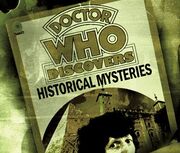
The sixth book in the series. (AUDIO: The Kingmaker)
- Main article: Doctor Who Discovers
Doctor Who Discovers was a series of educational children's books written by the Fourth Doctor during his time working with UNIT.
The intended title for the series was The Doctor, Who Discovers... but the publishing company misprinted the title, resulting in the author being mistakenly credited as "Doctor Who".
The Doctor completed five books in the series. He began work on the sixth, Doctor Who Discovers Historical Mysteries, but left it unfinished until a robot sent by the publishers from the 64th century invaded the TARDIS to forcefully remind the Fifth Doctor of his contractual obligation. (AUDIO: The Kingmaker)
Sarah Jane Smith's novels[]
- Main article: Doctor (series)
Sarah Jane Smith's first science-fiction novel, published "a few years on" from 1983, was entitled World War Skaro, (PROSE: The Roving Reporter) and presumably based on her witnessing of the tail end of the Thousand Year War alongside the Fourth Doctor. (TV: Genesis of the Daleks)
Circa 1991, Sarah was well-known to the public for publishing her "fanciful series" of science fiction novels. They featured the mysterious alien Doctor and his cheerful, long-suffering companion Nicola Jones as well as other characters such as the stalwart but slow-witted Rupert Thomason and the very stiff-upper-lipped General Lutwidge-Douglas. They also featured an organisation called the World Investigative Network which was clearly based upon UNIT. At the time of Kevin W. Parker's article on the series, the most recently published work in the series was Day of the Dinosaurs and the next title announced had changed from The North Sea Monster to a work tentatively titled Sutekh the Destroyer. Her publisher was Bullseye Press. (PROSE: An Army of Shadows)
Doctor was a series of short stories and novels which were written by Sarah Jane Smith and published from 1994 to 2003, adapted from her adventures with the Doctor. The short stories were published by the Metropolitan from January 1994 to November 1997 starting with Operation Golden Age. The novels were published by Virgin Publishing and from 1997 to 2003 starting with Noah's Ark. The Daleks were directly referred to in the title of one of these novels, Dalek Dawn, as were and the Kraals in The Kraal Invasion.
The series of books made Sarah a best-selling author and Amblin Entertainment were allegedly interested in producing one or more films based on the series.
In Moving On, the last story of the series, the character of the Doctor was "almost peripheral" to the plot which was a great change from the previous installments which had attracted criticisms that "the Doctor was a dominant male lead whose accomplices were feeble caricatures of helpless women". (PROSE: Moving On)
Time Surgeon[]
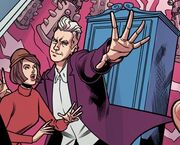
The Time Surgeon and Nurse Kara. (COMIC: The Fourth Wall)
- Main article: Time Surgeon
Loosely based on the Doctor's adventures, Time Surgeon was a popular comic book series in the 2010s written by Sonny Robinson, who was inspired after finding internet records of the Doctor. The eponymous Time Surgeon travelled through time in a flatpack wardrobe with Nurse Kara.
One of the stories from this series was named Day of the Deathroids, which saw the Time Surgeon and Nurse Kara face the Deathroids and the Minister. (COMIC: Invasion of the Mindmorphs)
Other works[]
After her encounter with the newly regenerated Eleventh Doctor in 1996, Amy Pond created numerous "cartoons" depicting "the Raggedy Doctor", leading to the Doctor being recognised as such by several Leadworth residents when he returned in 2008. (TV: The Eleventh Hour)
Steven Moffat was credited with writing down the afterword to a book of fiction about the Doctor, under dictation from a temporally-displaced Professor Candy who had been stranded in 1996 Birmingham by the Doctor. Professor Candy knew that this was an effect of the Doctor having retconned himself into fiction to avoid being noticed. (PROSE: Afterword)
In 2102, Zoe Heriot began writing stories based on the adventures of the Doctor. She began with The Dominators - Episode 1. (PROSE: Dream a Little Dream for Me)
In an alternate timeline, circa 2493, Vicki Pallister novelised some of her adventures with the First Doctor, for example she had works published titled Vicki and the Zarbi, Vicki and the Crusaders and Vicki and the Space Museum. She also wrote about the time she and Steven Taylor first met. (AUDIO: The Crash of the UK-201)
At some point, the Doctor wrote and published a book about the last day of the Last Great Time War, the primary bulk of which consisted of the Doctor Papers, which were punctuated by excerpts from the Doctor which, due to time constraints, they were forced to write "live" via a psychic time-space link as they were being read, taking advantage of the books publication on psychic paper to do so. An audiobook version was also available. The Doctor deliberately had the book marketed as pure fiction, per the insistance of the Brigadier that it remain classified information. (PROSE: The Day of the Doctor)
Meta-fiction universes[]
- Main article: Meta-fiction universe
Several different universes existed where the Doctor's adventures were prominently presented in a science fiction series called Doctor Who.
In a version of history where the Great Houses were fictional, the Houses came to regard Lawrence Burton as the Enemy because he wrote their very existence in works such as Against Nature, ensuring the continuation of the War in Heaven just to make interesting stories. (PROSE: We Are the Enemy)
In one universe, from 19 September to 24 October 1964, a six-part Doctor Who story entitled The Outlaws was first broadcast, starring actor William Hartnell as a version of the First Doctor, William Russell in a dual role as companion Ian Chesterton and Robin Hood, Jacqueline Hill as Barbara Wright and Carole Ann Ford as Susan Foreman.
There was coverage of the story in Doctor Who Magazine, Radio Times, Gallifrey Guardian, Doctor Who - A Celebration, The Discontinuity Guide and Doctor Who: The Television Companion.
A novelisation of the story called The Thief of Sherwood was also published that was written by the original writer Godfrey Porter. The Daleks had appeared by 1964 and Tom Baker was the Doctor for some of the 1970s. (PROSE: The Thief of Sherwood)
In one universe which the Eighth Doctor and Izzy Sinclair visited on 12 October 1979, Tom Baker played the Doctor. He managed to defeat Beep the Meep with his endless rambling by reminding Beep of his old foe, the Fourth Doctor. The Eighth Doctor learnt the truth when he was given a copy of DWM 1 (TV Action!) which featured Tom Baker's Doctor and a Dalek on the cover. (COMIC: TV Action!)
In another universe that the Eleventh Doctor visited in 2013, Matt Smith played the Doctor. Tom Baker and Peter Davison had played previous incarnations and the Doctor recommended Peter Capaldi to Steven as a future possibility. Elisabeth Sladen played Sarah Jane Smith.
While in this universe, the Doctor defeated a Cyberman from his universe with the help of Ally, gave some autographs, placed second in a cosplay competition and actually made it onto the set of the programme. The TARDIS was caught dematerialising on camera with one member of the crew voicing their happiness at the amount of money this was saving.

The Eleventh Doctor attends a Doctor Who convention. (COMIC: The Girl Who Loved Doctor Who)
Other characters and monsters that resembled those from the Doctor's universe included Amy Pond, Rory Williams, Azmael, Romulus Sylvest, Remus Sylvest, Mestor, Sontarans, Ice Warriors, Zygons, Peg dolls, K9, Krotons, Robot Yeti, K1, Dums, Vocs, Smilers, Sea Devils and Raxacoricovarlonpatorians. (COMIC: The Girl Who Loved Doctor Who)
There also existed another parallel universe where a television programme featuring the Doctor was extremely popular, but ended up being erased from history due to edits to the timeline made by the Bureau of Time Travel. One of these time travelers, Richard, explained this to the First Doctor. (PROSE: All Our Christmases, AUDIO: Deadline)
As a myth or legend[]
According to River Song, "good wizards" in fairy tales usually turned out to have been the Doctor, passing through. (TV: The Pandorica Opens)
Shortly before his death in March 2005, conspiracy theorist Clive Finch observed to Rose Tyler that the Doctor was "a legend woven throughout history".
When disaster comes, he's there. He brings the storm in his wake and he has one constant companion (death).
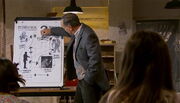
Colin Skinner shares his theories on the Doctor to LINDA. (TV: Love & Monsters)
Initially unaware of the Doctor's alien longevity or nature as a time traveller, Rose believed that the appearances of the Ninth Doctor were of a lineage of identical men, and that the title of doctor was passed down from father to son. (TV: Rose)
Colin Skinner, a member of LINDA, was of the view that the Doctor was not a man, rather a "collection of archetypes", including king, fool, stranger, and thief, which were found in "mythological structures". (TV: Love & Monsters)
In 64 AD, during the reign of Emperor Nero, the First Doctor visited Rome. (TV: The Romans) In 79 AD, the Tenth Doctor was convinced by Donna Noble to save the Caecilius family from the eruption at Pompeii. After their departure, the family kept a carving of the pair and the TARDIS, whom they respected as household gods. (TV: The Fires of Pompeii) In both instances, the appearance of a "blue box" was reported and was recalled as late as 451. (PROSE: Combat Magicks)
In the 14th century, it was said that a demon fell from the sky only to be intercepted by a "sainted physician" in a blue box, who smote the demon before disappearing. This was remembered by an English church convent, who depicted the box in a stained glass called the Legend of the Blue Box. The church and its glass stood as late as the 2000s,[nb 1] when the Woman recalled the story to Wilfred Mott. (TV: The End of Time)
During the Fourth Doctor's first visit to Mordee, he inadvertently imposed his personality on the supercomputer Xoanon. Generations later, the Sevateem began worshipping their own technology, forming a religion with Xoanon as a benevolent god. They worshipped the Doctor as a demonic entity known as the Evil One, a fact which clearly discomforted the Doctor.
As a complete unknown[]
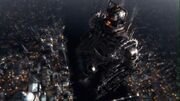
The CyberKing towers over London. (TV: The Next Doctor)
Although Jackson Lake believed that a CyberKing's rampage and the Tenth Doctor disintegrating the CyberKing from a big balloon in 19th century London would be "spoken of for centuries to come", it evidently wasn't, as the Tenth Doctor replied, "Yeah. Funny that," (TV: The Next Doctor) and the Eleventh Doctor guessed this was because the events were erased by the energy from the cracks in time. (TV: Flesh and Stone)
The Third Doctor initially theorised that the reason Great Britain was a fascist republic in the 20th century in the "Inferno universe" was somehow because of the fact his second incarnation had not been exiled to Earth. However, he later realised the Leader was one of the faces offered to him at his trial. (PROSE: Timewyrm: Revelation)
No mention of Harriet Jones' encounters with the Doctor was made in her autobiography, Do You Know Who I Am?. (PROSE: "Congratulations and Regrets")
In 2012, Henry van Statten, a collector of extra-terrestrial artefacts who claimed to own the internet, failed to recognise the Ninth Doctor. (TV: Dalek)
The Seventh Doctor wiped most references to himself from computer records, resulting in the Dalek Prime seeing no mention of his involvement in the Ministry of Defence's record of the Shoreditch Incident found during the 22nd century Dalek invasion. The Eighth Doctor attributed the actions of his predecessor to "good reason[ed]" paranoia. (PROSE: War of the Daleks) Later, wanting to be left alone, (HOMEVID: The Inforarium) the Eleventh Doctor erased himself from every database in the universe, making sure that no one had ever heard of him. (TV: Dinosaurs on a Spaceship, The Angels Take Manhattan, Nightmare in Silver) However, he was unable to erase Earth's records of him because he had played a major role in the planet's history and future, with organisations across the world having been influenced by him. (COMIC: Hunters of the Burning Stone)
On Gallifrey and among Time Lords[]
As a real person[]
Early life on Gallifrey[]
Due to the various alterations the Doctor made to his timeline while travelling through time, what really transpired to the Doctor during his time on Gallifrey was hard to decipher. (PROSE: Celestial Intervention - A Gallifreyan Noir)
Ashildr claimed that he was "a high born Gallifreyan" (TV: Hell Bent) and Clara Oswald said that he was born "into wealth and privilege", (TV: Robot of Sherwood)
The Doctor held the Time Tot hide and seek championship for forty-two years in a row. (COMIC: Weapons of Past Destruction)
During his first year at the Academy, the Doctor gained a troublesome reputation by trapping his teacher in a time-loop for a day, (PROSE: Island of Death) and "mucking about" with space-time portals, something the Tenth Doctor indicated were easy to create. (PROSE: Made of Steel)
Using his Academy Student Identification Code "Theta Sigma", the Doctor sent a letter to his then-tutor and head of Prydon Academy Borusa regarding his Interim Academy Report. In it, the Doctor takes issue with some of Borusa's comments in the report such as his supposed "tonal problems" and "propensity for vulgar facetiousness". This letter was one of the earliest items of correspondence from the Doctor's life. It was stored in the Academy Archives and reproduced with their permission in The Time Lord Letters. (PROSE: "Academic Progress")
At the Academy, the Doctor and the Master joined the "Gallifrey Academy Hot Five" band, with the Doctor playing the lead perigosto. (PROSE: Deadly Reunion) He was also part of the same zero-grav hyperball team as Padrac. (AUDIO: The Eleven)
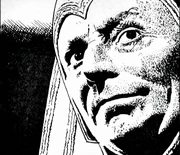
The Doctor worked as a Scrutationary Archivist in the Bureau of Possible Events, (PROSE: Lungbarrow) and rose high in the ranks of the Time Lords, (PROSE: The Eight Doctors) until he was considered a "superior" on Gallifrey by some, (COMIC: Flashback) with his second incarnation claiming to have held a seat on the High Council during the "latter years of [his] first incarnation", (PROSE: World Game) a claim repeated by the Scrolls of Gallifrey. (PROSE: The Legacy of Gallifrey) He also made powerful enemies due to his controversial views on the Time Lords' non-interference policy, even being accused of being a meddler. (AUDIO: The Beginning, PROSE: The Legacy of Gallifrey) He also lost popularity when he voiced his opinions on evil being a genuine force to his contemporaries, who found "such black and white notions of morality" to be "archaic". (PROSE: Strange England)
The Doctor learned of the existence of the miniscopes and was outraged by their cruelty to the specimens within. He campaigned to have them banned and, despite the non-interference policy of the Time Lords, was successful. (TV: Carnival of Monsters) His role in banning the use of miniscopes was known throughout nine galaxies. (PROSE: The Empire of Glass) He also successfully campaigned on Gallifrey to ban a chemical of Time Lord invention which converted vertebrae blood into acid, the formula for which he was never able to forget. (PROSE: The Age of Ambition) He also served as an ambassador for the Time Lords. (PROSE: The Exiles)
A handwritten note signed by the Doctor regarding his intentions to steal a TARDIS and explore after having "enough of monitoring and analysis" was discovered in the Time Capsule Storage Bays beneath the Citadel by a technician who immediately informed the Castellan, albeit too late to stop the TARDIS from leaving Gallifrey. However, since the stolen TARDIS was in the Repair Section, The Time Lord Letters noted that a considerable amount of time could have elapsed before the note was noticed. (PROSE: "Missing TARDIS")
Reputation as a renegade[]
While travelling alone, the First Doctor was found by the Time Lords, and placed into a "celestial retirement", during which he was scolded for meddling in history during his visit to Paris in August 1572. (PROSE: The Massacre) His retirement was eventually ended. (PROSE: The Meeting)

The Second Doctor at his trial. (TV: The War Games)
In their second incarnation, the Doctor was placed on trial for breaching the non-interference policy after contacting them for their help in clearing up the aftermath of the War Games, (TV: The War Games) officially recorded as occurring in Year 309906. (TV: The Deadly Assassin, AUDIO: Neverland, PROSE: A Brief History of Time Lords) The full transcript of the Doctor's telepathic message was preserved in the Panopticon Archives and later reproduced in The Time Lord Letters. (PROSE: "A Plea for Help") A written deposition in which he made his case for interference was also stored in the Panopticon Archives and was also reproduced in part in The Time Lord Letters. (PROSE: "A Case for the Defence") The trial resulted in the Doctor's companions Jamie McCrimmon and Zoe Heriot having their memory of their travels wiped. The Doctor was also exiled and forced to regenerate (TV: The War Games) although both of these sentences were postponed as the Doctor temporarily acted as a "hired gun" of the Celestial Intervention Agency (PROSE: World Game) His association with the agency ended when they decided they needed to cover up their visit to Space Station Camera. (PROSE: A Brief History of Time Lords)
During his exile, the Third Doctor was allowed briefly offworld to go on missions for them. Among them were his visit to Uxarieus to defeat the Master who had stolen information on the Doomsday Weapon, (TV: Colony in Space) his first visit to Peladon to ensure they joined the Galactic Federation (TV: The Curse of Peladon) and his visit to Solos. (TV: The Mutants) After he helped save Gallifrey with his two previous incarnations during the Omega crisis his knowledge of the TARDIS was returned to him and his exile was lifted with him being free to roam the universe once again. (TV: The Three Doctors)
After foiling a plan by the Master and the Daleks to start a war between Humans and Draconians the Doctor sent a message to the Time Lords from 2540 via the TARDIS telepathic circuits requesting that they help him send the TARDIS after the Dalek ship to wherever the Dalek army was waiting as he was close to collapse himself. The message was received and acted upon by Castellan Terrynate who stored the correspondence in the Panopticon Archives (TV: Frontier in Space, PROSE: "Telepathic Directions") and sent the TARDIS to Spiridon. (TV: Planet of the Daleks) The message was later reproduced in The Time Lord Letters. (PROSE: "Telepathic Directions")
Early in his travels with Sarah Jane Smith and Harry Sullivan the Fourth Doctor was tasked with a Time Lord, either Ferain or Valyes, (PROSE: Lungbarrow, AUDIO: Ascension) with averting the creation of the Daleks. He failed (TV: Genesis of the Daleks) and some people including the Eleventh Doctor considered this the "first shot" of the Last Great Time War. (COMIC: Hunters of the Burning Stone)
After the Doctor defeated Morbius on Karn after the Time Lords directed the TARDIS there without his approval, he sent a handwritten letter to the High Council which was delivered by trans-portal rather than than the usual telepathic method. In it, he made clear that he would have been happy to help should they have asked him while noting he was unhappy with Sarah almost being killed during the course of the adventure. This letter was reproduced in The Time Lord Letters. (PROSE: "Interference")
The Fourth Doctor later returned to Gallifrey after experiencing premonitions of the President's death, the Doctor left a handwritten note addressed to the Castellan of the Chancellery Guard warning them of potential threat. The note was delivered by Commander Hilred to Castellan Spandrell. (TV: The Deadly Assassin, PROSE: "Returning Home") A translated version was printed in The Time Lord Letters. (PROSE: "Returning Home") The President was assassinated by Goth and the Doctor was framed for the crime by him and the Decayed Master. During his trail for this crime he invoked Article 17 of the Constitution of the Time Lords which was a "guarantee of liberty" and stated that no candidate for the presidency could be debarred or restrained from presenting their claim. During the subsequent investigation the real culprits were discovered and Goth was killed leaving the Doctor as the sole candidate in the election meaning he was effectively Lord President-elect although he left that night (TV: The Deadly Assassin) When he returned and found Gallifrey without a President the Doctor was inducted officially as Lord President during which time he defeated the Sontarans and the Vardans in their invasion of Gallifrey. The Doctor left again soon afterwards, resigning the position to High Chancellor Borusa. (TV: The Invasion of Time) The Fifth Doctor later discovered his fourth incarnation's term had been stricken from the record. (AUDIO: Time in Offfice)
The Doctor returned to Gallifrey with Nyssa when it was discovered that somebody was using his biodata to attempt to free Omega from his anti-matter universe. Upon his arrival, he was detained by Commander Maxil and briefly issued with a Warrant of Termination to prevent Omega's return. Councillor Hedin was uncovered as the traitor but he was killed during the incident. (TV: Arc of Infinity) After President Borusa's involvement in the Death Zone affair was discovered and he was granted "immortality" by Rassilon, the High Council used its emergency powers to bestow the title of President upon the Fifth Doctor but he did not want it and immediately left in his TARDIS with Tegan Jovanka and Vislor Turlough, granting Flavia the title of Acting President until his return. (TV: THe Five Doctors) The Doctor was eventually forced to return to his responsibilities, however. During his tenure his companion Tegan served as Earth Ambassador to Gallifrey and sat on the High Council to avoid getting her memory wiped. (AUDIO: Time in Office)
The Doctor's tenure as President was looked upon with disdain by some. At the time of Romana III's first Reaffirmation Ceremony the Doctor's was the shortest stint of any President. Fremest, the Chancellor of Time Past, was of the opinion a Time Lord didn't deserve the title until at least a century or "maybe even not until their first Reaffirmation". Djarshar, the Chancellor of Time Future, looked thought little of the Prydonian Chapter calling them "Renegades, fugitives and lunatics" before highlighting the Doctor as "the most insolent of all of them". (PROSE: The Ancestor Cell)
Soon after his regeneration, the Sixth Doctor sent a message to the Coordinator of the Panopticon Archives from August 2100 informing them of Azmael's death. It detailed Azmael's help in defeating Mestor and the Gastropods during their occupation of Jaconda with the request he be written into the Gallifreyan Book of Honours and that his surviving Data Extract be uploaded to the APC Net so he could live on and be remembered in some fashion. The message was reproduced in The Time Lord Letters. (PROSE: "In Tribute")
The Sixth Doctor was put on trial by the Time Lords as a result of the significant loss of human life that occurred in the prosecution's first evidence during an impartial inquiry into his behaviour. (TV: The Mysterious Planet) The charges were later trumped up to genocide. (TV: Terror of the Vervoids) The Valeyard was promised by the High Council the Doctor's remaining regenerations if he suceeded in prosecuting him. The charges were eventually dropped. (TV: The Ultimate Foe) The final document from the trial proceedings, a statement from the Doctor from after the trial had ended was reproduced in The Time Lord Letters. In it, the Doctor left no doubt over his feelings about the incident by reiterating a speech from the trial about the society's corruption. He also offered to take the helm of the position of President once again if nobody suitable on Gallifrey could be found. (PROSE: "A Statement of Discontent")
The Sixth and Eighth Doctors began a Presidential Inquiry into the matter. Borusa was released from his punishment by Rassilon per the Eighth Doctor's request so that he might lead a Council of Administration. This period was known as the Borusa Interregnum. Due to the Tremas Master transmitting extracts of the trial on Public Access Television, there was insurrection in the Capitol, fuelled by the Celestial Intervention Agency. (PROSE: The Eight Doctors)
During the Last Great Time War[]

"Doctor no more." (TV: The Night of the Doctor)
Please help by adding some more information.
During the Last Great Time War, the War Doctor not only thought himself unworthy of the name of "the Doctor", (TV: The Day of the Doctor) dispatching the moniker immediately after regeneration, (TV: The Night of the Doctor) along with the "philosophies and ideals" shared with it, (PROSE: The Day of the Doctor) in favour of the title of "Warrior", (PROSE: The Stranger) but also of any identity at all, eventually leaving it to others to choose how they wished to address him, (PROSE: Engines of War) as he did not carry a name "as a rule". (AUDIO: The Eternity Cage) He would show great irritation, and even extreme bouts of anger, if anyone called him by his former title, especially if they did so after he committed what he considered an atrocity. (AUDIO: The Innocent, The Thousand Worlds, The Neverwhen, Eye of Harmony, The Enigma Dimension; COMIC: Kill God, Physician, Heal Thyself, The Clockwise War; PROSE: The Third Wise Man)
Before joining the Time War fully, the Eighth Doctor told Ohila he'd "like to think" that his name and "good man" were synonymous with each other. When he chose to regenerate into a warrior, he cited his opinion "I don't suppose there's any need for a doctor any more". (TV: The Night of the Doctor)
On the last day of the Time War, the Eleventh General called the meeting of the Doctor's war, tenth and eleventh incarnations all in one place at the same time "all my worst nightmares at once". He had previously called the War Doctor a "mad fool". (TV: The Day of the Doctor)
After the Time War[]
The Doctor did not have significant contact with Time Lord society that they would remember until their eleventh incarnation where he learnt that Gallifrey was not destroyed but locked away in a pocket universe. (TV: The Day of the Doctor)

The crack in time the Doctor first saw on Amy Pond's bedroom wall on Trenzalore. (TV: The Time of the Doctor)
The Question, "Doctor who?", a transmission being broadcast across all of time and space, making it the "oldest question in the universe," used as a code by the Time Lords on Gallifrey who were sealed inside a pocket universe. They were transmitting the message through a crack in time on the planet Trenzalore, asking the Doctor to speak his true name in order to let them know that it was safe to emerge from the pocket universe. Along with the Question, the Time Lords also transmitted a Truth Field which enveloped the town of Christmas so that the Doctor could not lie if he were to answer the Question. This prompted a siege on the planet by a host of alien races who wanted to prevent the start of another time war, but they were held off for almost 900 years by a combination of the Doctor and a force field that had been put in place by the Papal Mainframe.
The conflict on Trenzalore eventually boiled down to the point that only the Daleks remained at war with the Church and the Doctor. The Doctor, having run out of regenerations and convinced of his foreseen death on the planet, intended to let the Daleks kill him, but Clara Oswald believed that the future could be changed and implored the Time Lords to help the Doctor. Ultimately, she became the one to answer the Question, although she stated that the Doctor's real name was simply "the Doctor," and that the meaning behind that answer was a sufficient-enough reason for the Time Lords to give him their support, which they then did by changing the future and granting the Doctor a brand new regenerative cycle, thereby allowing him to defeat the Daleks and survive the battle. (TV: The Time of the Doctor)
For his part in the Time War, the Twelfth Doctor was acknowledged as a "war hero" by the Eleventh General. It was for this reason that Gallifreyan soldiers, some of whom had served with the Doctor, chose to side with the Twelfth Doctor against Lord President Rassilon in a coup. (TV: Hell Bent)
As a work of fiction[]
By Year 10639.5 of the Rassilon Era there were some on Gallifrey who believed the Doctor to be a fictional creation. Elucidator Ziggi was among them and and wrote a book of the subject titled Doctor Who?: In Search of the Old Times Fraud. In a later interview he elaborated on this by saying that the Doctor was a "figment of the mythic imagination" and "a convenient hero figure who [existed to] plug gaps in the understanding of the past". He cited the fact he was "supposed to" have launched the Hand of Omega, killed a great president and foiled the Sontaran invasion of Gallifrey before concluding that the Doctor was never real but a made-up story for children. (COMIC: The Final Chapter)
During the War in Heaven, a book redacted to read as Doctor ? in an Exciting Adventure With the Enemy, was illicitly shared by recently Loomed Time Lords. (PROSE: The Taking of Planet 5) The book's proper title was Doctor Who in an Exciting Adventure with the Daleks, and a copy was given to the Eighth Doctor by the "Jane Fonda" Iris. (PROSE: Bafflement and Devotion)
As a myth or legend[]

The Other. (PROSE: Lungbarrow)
According to some accounts, the Doctor was a reincarnation of the Other, one of the legendary Founding Fathers of Gallifrey. He threw himself into the Prime Distributor of the Looms to be re-Loomed ten million years later to the House of Lungbarrow as the Doctor.
The Other was influential during the Dark Times on Gallifrey after the cult of Pythia had ended. (PROSE: Lungbarrow)
Scholars later called documents concerning Rassilon, Omega and the Other the ROO texts. (PROSE: Goth Opera) A minor Gallifreyan festival known as Otherstide was celebrated yearly in his honour. It coincided with the Doctor's birthday. (PROSE: Lungbarrow, AUDIO: Cold Fusion) Secret societies on Gallifrey were dedicated to the worship of Rassilon, Omega, and the Other. (AUDIO: Intervention Earth)
A comparable but different account showed the Spy Master claiming that the Doctor had originally been the Timeless Child, the adopted child of Gallifrey's founder Tecteun. The Timeless Child was erased fro the official histories by the early Time Lords, who wanted a "noble creation myth", finding the idea that their regeneration had been stolen from another species via experimenting on a child less than edifying. (TV: The Timeless Children) However, the image of the Timeless Child remained buried in all the memories of the Time Lords, (TV: Spyfall) and most of the Timeless Child's history was recorded deep in the Matrix, although parts of their story involving the Division were redacted, with only the allegorical images of Brendan's life remaining. (TV: The Timeless Children)
The Father of Time, whom the First Doctor later nearly recognised as his own future self, was known by him on sight when he materialised inside the TARDIS. (COMIC: The Test of Time)
As a complete unknown[]
The Doctor did not have an impressive career at school, passing his qualifying exams to become a Time Lord with only 51% — the lowest possible pass mark — on his second attempt. (TV: The Ribos Operation) However, this was a deliberate ploy to not to draw undue attention to himself, so he could eventually leave Gallifrey. (PROSE: Tears of the Oracle)
Other realities[]

The First Doctor is crowned Lord President. (COMIC: Time & Time Again)
In an alternate timeline created by the Black Guardian as revenge on the Doctor, the First Doctor never left Gallifrey, eventually becoming Lord President and forming an alliance with the Dalek Empire. The Seventh Doctor, Benny, and Ace, with instructions from the White Guardian, were able to retrieve the Key to Time to set the timeline straight. (COMIC: Time & Time Again)
In a parallel universe, the First Doctor pursued a career as an author. He wrote the first science fiction historical romance, An Adventurer in Time and Space, with the Possibility Generator. His other works included A Journey to Ice-Askar, The Winter Star and An Exciting Adventure with the Hassites. His stories were popular with generations of Gallifreyan children. (AUDIO: Auld Mortality) The Doctor eventually left Gallifrey and became a renegade. (AUDIO: Auld Mortality, A Storm of Angels)
In other cultures[]
Skaro, the Daleks and the Thal diaspora[]
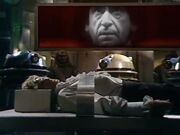
The Daleks identify the Third Doctor. (HOMEVID: Day of the Daleks: Special Edition)
Having been sent on an ultimately unsuccessful mission to prevent the creation of the Daleks, the Fourth Doctor encountered the Kaleds, the Thals and the first Daleks presented by their creator Davros. Most notably, Davros became aware that the Doctor was an enemy of future Daleks, only to be seemingly killed by his own creations soon after, (TV: Genesis of the Daleks) actually being placed in suspended animation. (TV: Destiny of the Daleks)
From his perspective, the First Doctor first visited Skaro with Susan Foreman, Ian Chesterton and Barbara Wright. Encountering both the Daleks and the Thals, he helped the former species defeat the latter, who intended to destroy them. (TV: The Daleks) Over the following generations up to 2540, a legend recalled a figure known as the Doctor with three companions, arriving in what he called a TARDIS when the Thals were in their greatest peril. (TV: Planet of the Daleks) The Doctor and his three companions were each remembered by name and by appearance, as legendary figures, and collectively dubbed "the Travellers" amongst the Thals. (AUDIO: Return to Skaro)
The Ninth Doctor recalled that he was known as "the Oncoming Storm" in the ancient legends of Skaro. (TV: The Parting of the Ways)
Recognising the First Doctor's role in delaying the conquest of Earth, the Daleks pursued him and his companions through time in an attempt to kill him. (TV: The Chase)
The Fifth Doctor was recognised by the Daleks as they moved to retrieve Davros following the Dalek-Movellan War. (TV: Resurrection of the Daleks)
The Sixth Doctor was recognised by Daleks created by Davros on Necros. However, contemporary Daleks loyal to the Supreme Dalek failed to recognise him, observing that his image did not compute with the known appearance of the Doctor. (TV: Revelation of the Daleks)
During the Shoreditch Incident, the Seventh Doctor was recognised by both Davros' Imperial Daleks and the Renegade Daleks led by the Supreme Dalek. When confronted by the Doctor, Davros observed that he had "changed again". (TV: Remembrance of the Daleks)
The "Metaltron", a survivor of the Last Great Time War, recognised the Ninth Doctor as an enemy when he identified himself. (TV: Dalek) Similarly, the Cult of Skaro identified the image of the Tenth Doctor as an enemy. (TV: Army of Ghosts)
The Daleks were among the Inforarium's most dangerous clientele who purchased information regarding the Doctor. (HOMEVID: The Inforarium)
The Eleventh Doctor found that, having accessed the Dalek pathweb, Oswin Oswald had removed the memory of the Doctor from the Dalek race. (TV: Asylum of the Daleks) Ultimately, however, the Daleks regained their knowledge of the Doctor, having harvested information on him from the cadaver of Tasha Lem. (TV: The Time of the Doctor)
During the conflict with the Combined Galactic Resistance, the Dalek that would be named Rusty recognised the Twelfth Doctor on sight. (TV: Into the Dalek) The Thirteenth Doctor had only to mention her name to spark fear in the Reconnaissance Dalek, who had been one of the first to leave Skaro, having long since lost contact with them. (TV: Resolution)
Cybermen[]
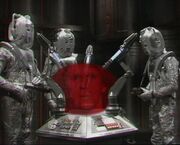
The Cybermen find the Fifth Doctor. (TV: Earthshock)
In the late 20th century, the Faction's Cyber-Planner recognised the Second Doctor and Jamie McCrimmon from Planet 14. (TV: The Invasion)
In 2526, CyberNeomorphs descended from the Mondasians had video records the Doctor, recalling the encounter with the First Doctor in 1986, the Second Doctor on Telos, and the Fourth Doctor's thwarting of their attempt to destroy Voga. The Cyber-Leader identified the Fifth Doctor as a new incarnation. (TV: Earthshock)
The Sixth Doctor was recognised by the CyberNeomorphs on his return to Telos. (TV: Attack of the Cybermen)
The Seventh Doctor was recognised on sight, albeit as a "new appearance", by the Leader of the CyberIsomorphs. (TV: Silver Nemesis)
The Cybermen were among the Inforarium's most dangerous clientele who purchased information regarding the Doctor. (HOMEVID: The Inforarium)
Gharusa Prime[]
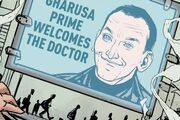
A holo-advertisement featuring the Doctor. (COMIC: Doctormania)
- Main article: Doctor Who? (Doctormania)
A holo-show broadcast in the form of minisodes called Doctor Who? existed in the 38th century and was especially popular on Gharusa Prime. Its main characters were the Doctor played by Slist Fayflut Marteveerthon Slitheen in a skin suit of the Ninth Doctor and his companion Penny, actually another disguised Slitheen. Fans of the series were called Doctorians and a group called the Doctor Who Appreciation Society existed, to which Yani Mamora belonged.
The Doctor was a Time Lord from Gallifrey who left his homeworld to defend from alien threats. He seemed to favour Gharusa Prime over other planets and had been voted Cosmopolitan's sexiest planetary saviour nine years running by 3764. He had also released an autobiography titled Doctor's Orders.
When a Raxas Alliance peace conference was held on Clix and the Doctor attended with his real counterpart's companion, a kidnapped Rose Tyler, his true identity was unmasked. The real Ninth Doctor used a data-virus to remove all trace of the fake Doctor and the show from the Galactic Net, making it cease to exist. (COMIC: Doctormania)
As President of the Universe[]

- Main article: Unbound Universe
In the Unbound Universe, after a Great War, the Unbound Doctor was left as Ruler of the Universe as everybody before him in the line of succession had been killed. This was much to the anger and displeasure to many races and people, many of whom didn't trust him, and whenever he met any of these individuals they would mock or deride him for his actions during the Great War. (AUDIO: The Library in the Body)
After the Doctor began taking up his presidential duties more seriously, the Doctor had Ebbis as a spokesperson, who defended his actions to the press including a radio host who thought of the Doctor as a bad politician. (AUDIO: Asking for a Friend)
Towards the end of his tenure, the Doctor became increasingly frustrated as his enemies surrendered as soon as he asked them to instead of giving him a good fight. (AUDIO: Truant) He was eventually impeached in a rigged vote of the Parliament of the Universe which was headed by the Mother Superior and replaced by the Unbound Master. He left and travelled with Bernice Summerfield to her universe soon afterwards. (AUDIO: The True Saviour of the Universe)
Others[]
According to River Song, "doctor" was the word for "healer" and "wise man" across the universe because of the Doctor's prominent presence as a force for good in it. After the Battle of Demons Run, she asked him what might the meaning of the word become if he carried on the same way, acknowledging that to the people of the Gamma Forests it already meant "mighty warrior". (TV: A Good Man Goes to War)
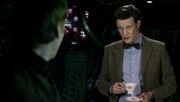
The Eleventh Doctor explains what he has done to an Inforarium guard. (HOMEVID: The Inforarium)
Wanting to be left alone, (HOMEVID: The Inforarium) the Eleventh Doctor erased himself from every database in the universe, making sure that no one had ever heard of him. (TV: Dinosaurs on a Spaceship, The Angels Take Manhattan, Nightmare in Silver) Though he could not remove the information about him from the Inforarium's data banks, he managed to reverse engineer the memory-proofing ability of the Silence so that no one could retain any knowledge that they gained about him from there. (HOMEVID: The Inforarium)
The Abzorbaloff, a native of the planet Clom, studied the Doctor. With a particular interest in the Tenth Doctor, he came to Earth to search for him, wishing to absorb his immense experience and knowledge and take the TARDIS. (TV: Love & Monsters) The Family of Blood hunted the Doctor as they sought a Time Lord to increase their limited lifespans. (TV: Human Nature/The Family of Blood)
In 2009, General Staal of the Tenth Sontaran Battle Fleet recognised "doctor" as the name of a "facechanger" and enemy of the Sontarans who led the battle in the Last Great Time War, an object of shame for the Sontarans as they were forbidden from taking part in it. He took pride in capturing the TARDIS, the Doctor's "infamous vessel". (TV: The Sontaran Stratagem/The Poison Sky)
The Inforarium sold information about the Doctor to the Sontarans, among their more dangerous clientele. (HOMEVID: The Inforarium)
After River Song's death, the Doctor and Donna Noble decided to leave her diary in the biography section of the Library where it remained for a time (TV: Forest of the Dead) before it was retrieved by Nardole after the Twelfth Doctor's night on Darillium. (TV: Extremis) River used it to record their adventures together with the book itself acting as an indicator to where the Doctor was in their personal timeline. (TV: Silence in the Library et al.) Among other things such as detailed information on alien species, the diary contained pictures of all the Doctor's incarnations, (TV: The Time of Angels) including the War Doctor. (TV: The Husbands of River Song)
There existed books about Rose Tyler's and the Ninth Doctor's travels to the 1920s, the Justicia Penal System, and the war against the Mantodeans. (PROSE: Meet Rose)
Behind the scenes[]
Invalid sources[]
Doctor Who?[]
Please help by adding some more information.
The comic strip series Doctor Who? often broke the fourth wall to various extents, or otherwise referred to the Doctor's in-universe fame. Several strips were played off as the Doctor speaking directly to the reader and answering a question from the fandom. Furthermore, one strip showcased the existence of an Annual Gallifreyan Doctor Who Con, attended by several of the Doctor's actual incarnations (including Dr. Who!).
The Doctor Who Fun Book[]
Several parodical stories in 1987's The Doctor Who Fun Book presented contradictory looks at the production and fandom of Doctor Who, at different "levels" of metafiction.
The first of these was NOTVALID: Introduction, where a bemused Peter Davison had to deal with a fan asking him for "Tom Baker's autograph".
NOTVALID: A Life in the Day of a Doctor Who Production, meanwhile, was a parody of a behind-the-scenes making-of documentary which claimed to be a sneak peek into the future, as the making-of documentary of the 2003 Doctor Who Fortieth Anniversay Special. NOTVALID: Untitled 2, meanwhile, featured a version of Louise Jameson getting into character as Leela to the extent that she murdered several people in real life using her prop knife while on her way to work.
NOTVALID: Doctor Who 3 - The Third Motion Picture was a metafictional continuation of the adventures of Dr. Who and Susan from Dr. Who and the Daleks framed as the rediscovered lost script for a third "Dalek movie", which Peter Cushing had previous attempted to suppress and indeed destroy. The typed script became increasingly ludicrous and fourth-wall-breaking, culminating in Susan realising that she was a fictional character and the Scriptwriter's plaything, and reaching out into the real world to slay the Scriptwriter, hence ending the franchise and liberating her and her companions from his authorial power.
In the comic NOTVALID: The Final Script, Melanie Bush is somehow reading a copy of The Doctor Who Fun Book itself. In that story, a reference is also made to the Peter Cushing movies, as the Doctor comically cites Roberta Tovey as one of his defeated enemies.
NOTVALID: Outta Space, the metafictional epilogue to the book, featured Mr Howett and Mr Quinn as characters having just finished writing and illustrating every single page of The Doctor Who Fun Book — meaning they must now reluctantly return to their usual job; working the huge bellows which produces the TARDIS's "Vworp! Vworp!" sound every time it dematerialises!
The parodical short story NOTVALID: TARDIS Stolen! dealt with the Gallifrey Gazette's coverage of the flight of the First Doctor from Gallifrey, and also suggested that during his Academy days, the Doctor did some stage acting work, including in a school production of The Army Game.
In addition, NOTVALID: Who Was 'Ere! dealt with Dicky Howett and Tim Quinn's investigation into appearances made by the Doctor on Earth earlier than in November 1963 (a reference to An Unearthly Child). Most of the entries in the resulting dossier thus dealt with the Doctor in Earth history, but there was also a North American Totem depicting a Dalek and the Doctor's TARDIS (among other creatures), taken as evidence that the Doctor beat Christopher Columbus to the New World by Quinn and Howett.
Dez Skinn's nightmares[]
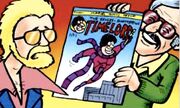
Stan Lee's Timelord. (NOTVALID: The Origin of Doctor Who Magazine)
In NOTVALID: The Origin of Doctor Who Magazine, a special The Daft Dimension-branded comic story printed in 2019's DWM 544 in honour of Doctor Who Magazine's 40th anniversary, a fictionalised look at Dez Skinn's creation of the magazine was provided. In the story, Televisual Comic had previously been printing the Doctor Who comics; upon that book's loss of their licence, Skinn, the protagonist, intends to take the idea of a Doctor Who comic book to his bosses at Marvel UK.
Before it gives a relatively realistic account of the creation of the well-known Doctor Who Weekly as it really existed, the story briefly segues into a nightmare sequence where the protagonist attempts to pitch the idea to Stan Lee and to Wayfleet Publications, resulting in the creation of two horrendously inaccurate retools of Doctor Who, Lee's superheroic Timelord (where the titular character is a sonic sceptre-wielding human whose secret identity is a lowercase-D doctor) and Lionel Bluster-Outrage's pre-school-oriented Sergeant Who's Jelly Baby Adventures (starring "Sergeant Who").
Film Star Wins Oscar—Misses Premiere![]
Film Star Wins Oscar—Misses Premiere! was a parodical short story about the release of Dr. Who and the Daleks, printed in Issue 28 of TV Century 21 alongside more conventional material about the Daleks. It focused on the premier of "Doctor Da and the Humanies", a movie in which Sir Seamus Vampire starred as "Dr. Da", who travelled in the spaceship Dardis to the planet Eartho where he fought the City Men and their terrifying umbrella weapons.
On the Icy Edge of the Galaxy...[]
In On the Icy Edge of the Galaxy..., a promotional 1980 Fourth Doctor comic story tying in with the release of a soundtrack LP of Genesis of the Daleks, the Doctor was seen attempting to purchase an in-universe record entitled Genesis of the Daleks, from "circa 1979", at the Inter-Gallactic Record Shop on Gamma-Ursa 9, but was prevented by two actual Daleks. He resolved to try to buy a copy on Terra instead.
Other matters[]
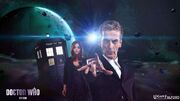
The fan-made poster used on the bus in In the Forest of the Night.
- The references to Peter Cushing playing Doctor Who in films is a reference to his character of Dr. Who in the Dalek films. His appearances are considered not a valid source for writing on this wiki.
- Steven Moffat had wanted a poster of the Cushing films in The Day of the Doctor but could not afford the rights. This was not a problem in the novelisation.
- The bus seen in In the Forest of the Night was cardboard, as it was too hard to transport a real bus into the forest. The advert seen on the bus was a fan-made poster for series 8 of Doctor Who, made by Logan Fulford.
- The Lethbridge-Stewart series of publications implies that Doctor Omega is the in-universe version of the William Hartnell era of Doctor Who.

A Doctor X VHS seen in WC: Varunastra.
- Other in-universe analogues of Doctor Who include Doctor X, Professor X and Time Surgeon.
Real world cultural impact[]
Please help by adding some more information.
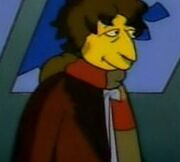
The Fourth Doctor appears wearing his signature scarf in The Simpsons.
As the titular star of Doctor Who, the character of the Doctor has been parodied or referenced since the programme's inception in the 1960s.
Tom Baker's Fourth Doctor is among the most recognisable and most referenced incarnation of the character, especially in the United States. For example, the Doctor resembled their fourth incarnation for all of their several appearances on The Simpsons. Baker's Doctor has also appeared twice in Futurama and the opening titles from his era was used in Family Guy when a ship entered hyperspace. The Fourth Doctor's scarf was a staple of the character and has often been used to reference Doctor Who such as when Sheldon cosplayed the character in The Big Bang Theory.
Footnotes[]
- ↑ Both Planet of the Dead and The End of Time are referred to in dialogue as taking place after the end of Journey's End, which is set in either 2008, according to TV: The Fires of Pompeii, TV: The Waters of Mars, and AUDIO: SOS (and heavily implied by TV: The Star Beast and TV: The Giggle), or six weeks after the middle of May 2009, circa June, according to PROSE: Beautiful Chaos. However, the year of The End of Time is unspecified, as is whether or not it is intended to be the Christmas immediately after Journey's End.
